Many people with upper back pain struggle to get a full night of restful sleep. The right position and proper support often helps by easing discomfort and allowing the body to recover. Sleeping on the back with the right pillow support usually offers the best spinal alignment and helps reduce upper back tension overnight.
A medium-firm mattress and a supportive pillow are both important in managing pain. Even small shifts in nightly routines or improvements to the sleep environment can increase comfort and help keep upper back issues from escalating.
This article walks through effective ways to sleep better with upper back pain. It provides practical guidance on sleep positions, mattress selection, and simple remedies that can ease discomfort and improve rest.
Key Takeaways
- Proper sleep positions maintain spinal alignment and reduce pain.
- A good mattress and pillow help support the upper back.
- Small sleep habit changes and environment changes can improve comfort.
- Optimal relief from upper back pain comes from combining a medium-firm mattress that has targeted support with a sleeping position that ensures proper spinal alignment, such as resting on the back or side with appropriate cushioning.
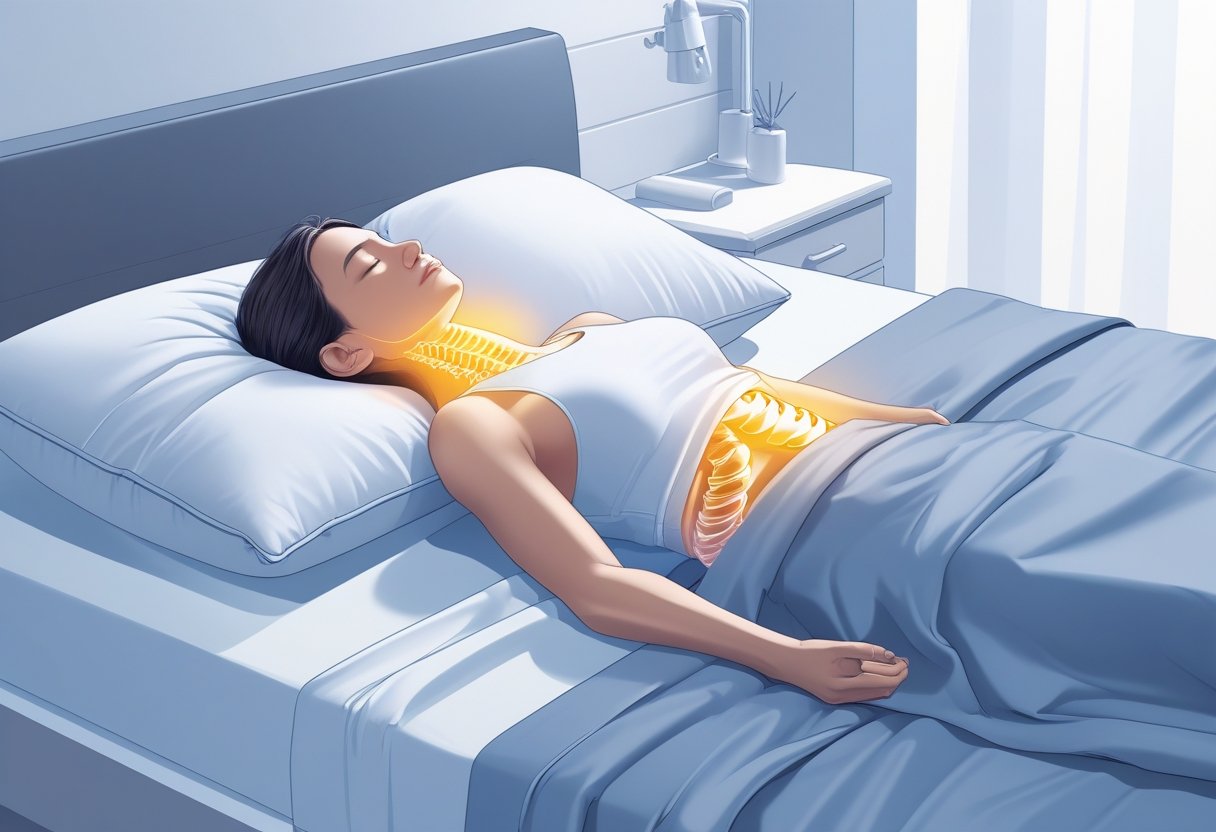
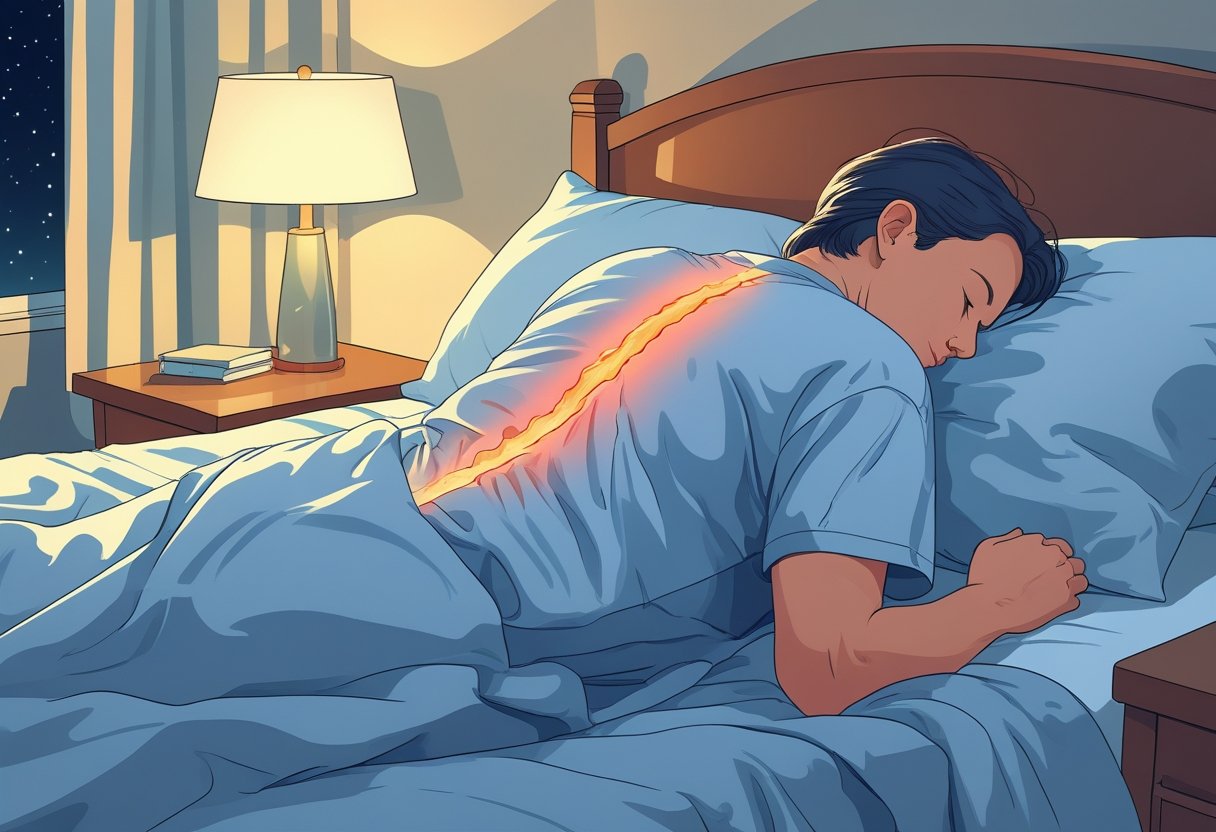
Upper back pain during sleep may result from body positioning, mattress quality, or underlying health issues. Pain usually feels worse overnight because pressure builds on the spine while muscles stay inactive for hours. Knowing the causes makes it easier to find relief and improve sleep quality.
Common Causes of Nocturnal Upper Back Pain
Upper back pain after sleep comes from muscle strain, poor posture, or prior injury. Muscle tension may develop throughout the day and tighten more at night. Less common conditions like arthritis or spinal infections can also make pain feel worse by morning.
An unsupportive mattress puts uneven pressure on the spine, which leads to stiffness and soreness, especially across the middle back. Poor posture while sleeping may also trigger aching in the ribs and upper back. Long periods of inactivity at night allow inflammation to settle in. This heightens pain upon waking. If the pain continues or intensifies, it’s best to consult a healthcare provider to rule out underlying conditions.
The Role of Sleeping Position
The way someone sleeps directly affects upper back pain. Stomach sleeping tends to flatten the spine’s natural curve and twist the neck, which can lead to stiffness or discomfort upon waking.
Back sleeping usually supports spinal alignment well. It holds the spine in a neutral position and spreads body weight evenly, easing pressure on the upper back. Still, this position may not work for everyone, especially those with sleep apnea or during pregnancy. Side sleeping, with legs gently drawn up, supports spinal alignment. A pillow between the knees and under the head can provide added relief by maintaining posture.
Impact of Sleep Posture on Spinal Health
Posture during sleep either supports or disrupts the spine’s natural curve. When the spine stays aligned, muscles experience less strain, and joints feel less pressure. Poor posture, like twisting or slumping, can force the spine into unnatural positions. This adds stress to the vertebrae and surrounding tissue, which may lead to chronic upper back pain or discomfort upon waking.
A medium-firm mattress and well-shaped pillow help reinforce healthy posture. These tools provide proper neck and shoulder support, which is essential for preventing pain during sleep. Making posture adjustments early may reduce the chances of dealing with lingering upper back pain after rest.
Finding the right sleeping position can ease upper back pain and prevent further discomfort. Proper support and alignment during sleep reduce strain on muscles and joints, especially around the shoulder blades. Adjusting posture and pillow placement remains essential for comfort and recovery.
Back Sleeping: Supporting Spine Neutrality
Sleeping on the back is the best option for upper back pain. This position allows the spine to maintain its natural curve without twisting or bending. A medium-firm mattress provides adequate support without letting the body sink too deeply.
Placing a thin pillow under the neck and shoulders maintains cervical spine alignment. Adding a pillow beneath the knees reduces pressure on the lower back and supports overall spinal neutrality. This setup minimizes tension in muscles between the shoulder blades, reducing upper back pain during rest.
Back sleepers should avoid thick, high pillows that push the head forward. Proper elevation of the neck and shoulders with well-placed pillows encourages comfort and lowers pain caused by poor sleeping positions. For more details, see tips on how to sleep with upper back pain.
Side Sleeping and Spine Alignment
Side sleeping is great when done correctly. Curling the legs slightly toward the chest, similar to a fetal position, supports spinal alignment and eases strain on the upper back. A firm pillow between the knees keeps hips aligned and prevents spinal twisting. The pillow under the head should fill the gap between neck and mattress to avoid neck bending.
This position reduces pain between shoulder blades after sleep by maintaining a neutral spine. Still, side sleepers need to ensure the mattress does not feel too soft, as excessive shoulder sinking can worsen upper back pain due to sleeping posture.
Avoiding Stomach Sleeping
Sleeping on the stomach usually ranks as the worst position for upper back pain. It puts extra pressure on the spine and flattens its natural curves. The neck twists to one side, which strains the neck and shoulder muscles. This position causes pain between the shoulder blades after sleep due to muscle tightening and poor alignment. For those who prefer stomach sleeping, placing a thin pillow under the lower abdomen may ease some spinal strain but cannot fully correct the issues caused by this position.
Changing sleep positions offers a better path to reducing upper back pain. Stomach sleeping tends to increase discomfort and hinders proper recovery, making it harder to manage pain while lying down.
Tips for Transitioning to Healthier Positions
Changing sleep habits requires time but proves essential for easing upper back pain. Supportive pillows can assist in shifting from stomach or poor side sleeping toward back sleeping. Beginning with short periods in the new position and gradually extending the time helps the body adjust. Pillows placed to support the neck, knees, and sides prevent rolling back into old habits.
A medium-firm mattress delivers balanced support, and promotes proper spinal alignment throughout the night. Avoiding poor posture and consistently practicing healthier sleep positions brings noticeable relief.
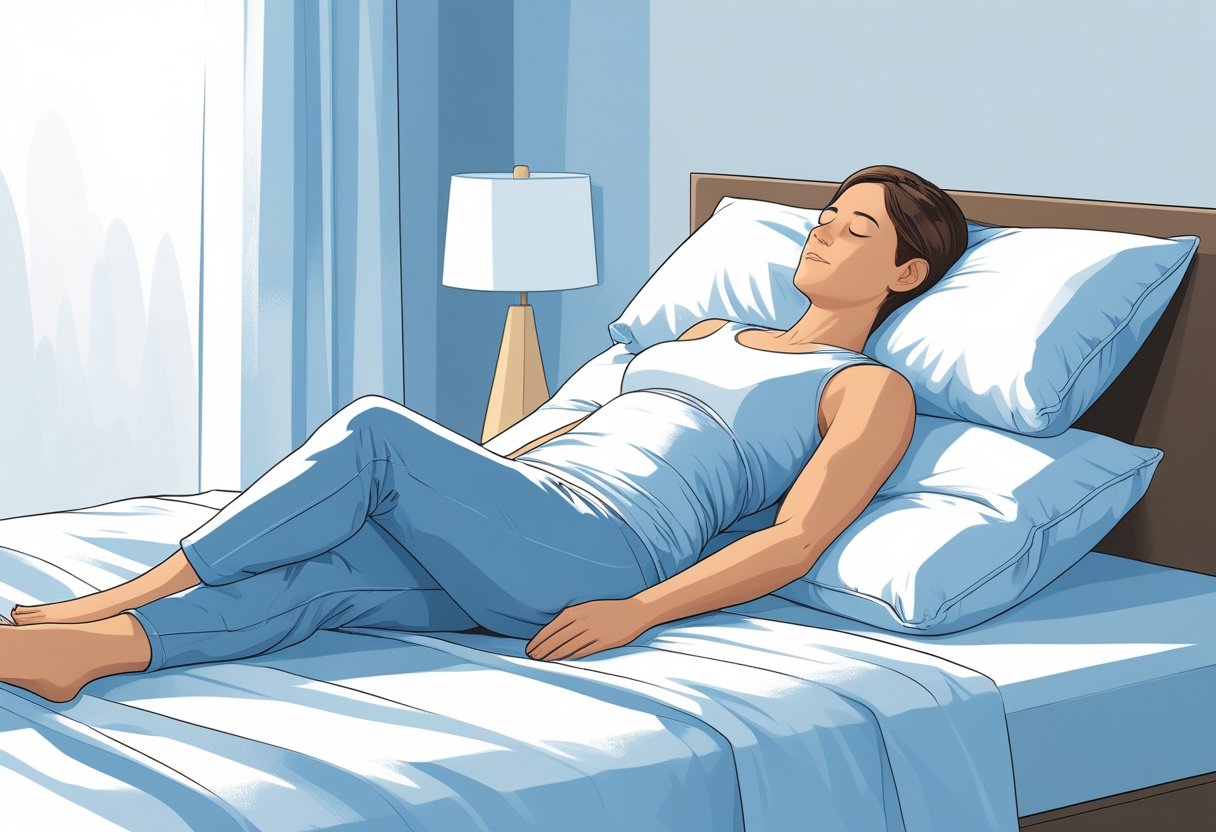
Creating the right sleep environment can ease upper back pain and improve rest. Proper support from a mattress and pillows keeps the spine aligned. Correct pillow placement reduces neck and upper back pain after sleeping and prevents stiffness or soreness.
Choosing the Right Mattress
A mattress that offers balanced support proves essential to avoid upper spine pain after sleep. It should be firm enough to keep the spine neutral yet soft enough to cushion pressure points. Side sleepers often benefit from a medium-soft mattress, while back sleepers may require firmer support.
A mattress that sags or lacks support increases upper back pain caused by lying down too long. Replace old mattresses showing signs of wear. Memory foam or hybrid mattresses provide proper spinal alignment and comfort.
Selecting Supportive Pillows
Pillows play a major role in preventing neck and upper back pain after sleep. The pillow must support the natural curve of the neck without pushing the head forward or letting it fall backward.
Side sleepers generally need a firm, thick pillow to fill the gap between shoulder and neck. Back sleepers often find a medium loft pillow supports the head and neck evenly. Pillow materials such as memory foam or latex also influence comfort and pain relief.
Pillow Placement for Proper Alignment
How pillows get placed can affect sore or stiff upper back after sleep. Placing a pillow under the knees while lying on the back helps align the spine by reducing lower back strain.
Side sleepers benefit from placing a pillow between the knees to keep hips, pelvis, and spine aligned. Supporting the arms with a small pillow also helps, especially for those who experience upper back or neck pain after sleeping. Stomach sleepers may find that a thin pillow under the pelvis reduces pressure on the upper spine.
Making these key adjustments supports the upper back and may improve the best sleeping position for upper back pain.
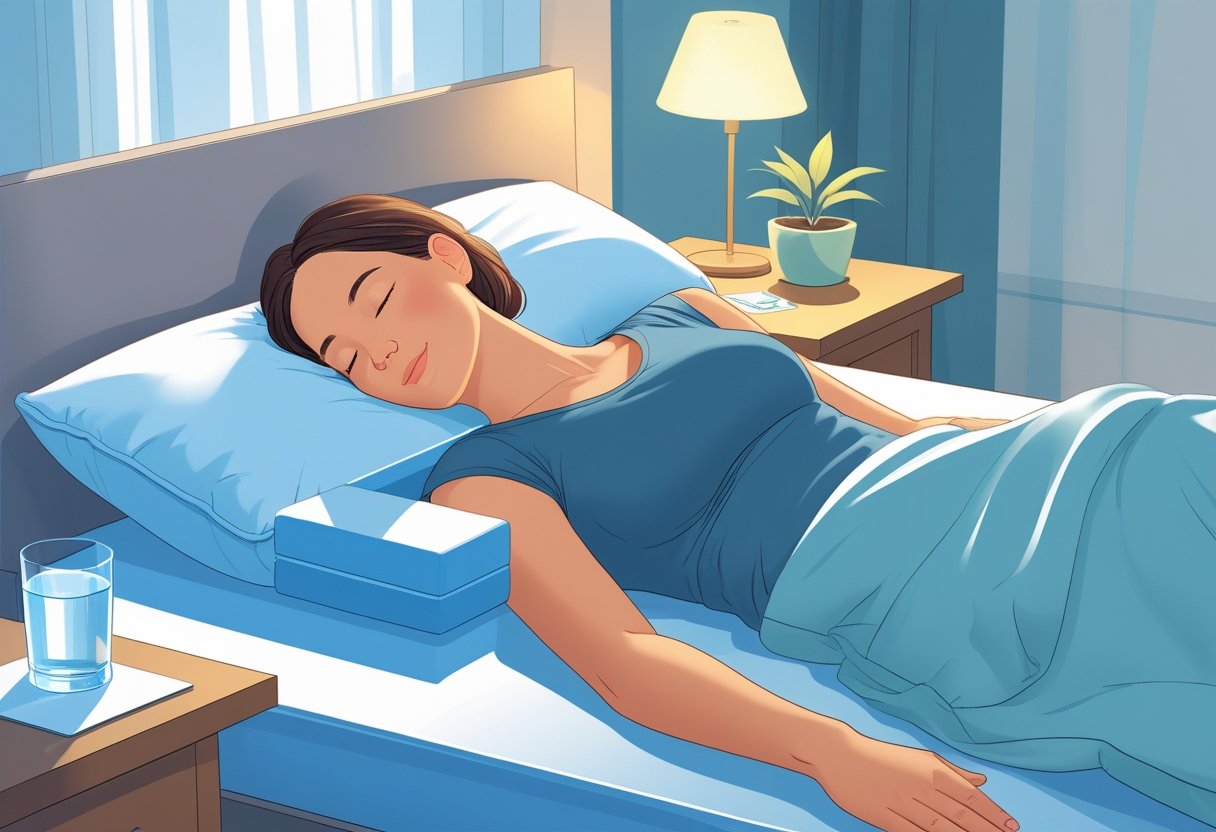
Improving upper back pain overnight begins before bedtime. Daily habits and deliberate actions help reduce stiffness, soreness, and pain upon waking. These small changes focus on easing muscle tension, correcting posture, and strengthening the back.
Evening Routines and Stretches
A calm evening routine can ease upper back soreness that shows up after sleep. Gentle stretches for the upper back, shoulders, and neck relax tight muscles and support healthy blood flow. Shoulder rolls, neck tilts, and chest openers are simple and effective. It’s best to hold each stretch for 20-30 seconds without bouncing. Intense or painful movements before bed should be avoided, as they may worsen discomfort.
Applying heat for 15 minutes before sleep also helps with stiffness. A warm shower or heating pad relaxes the muscles. When paired with stretching, this promotes comfort and may lessen pain during the night and in the morning.
Ergonomics and Daytime Habits
The way a person moves through the day has a major effect on upper back pain that shows up every morning. Poor posture, especially during long hours of sitting, strains the upper back and spine. Keeping both feet flat, shoulders relaxed but upright, and the back supported helps avoid unnecessary strain. Ergonomic chairs and screens set to eye level reduce forward head posture and shoulder rounding.
Short movement breaks every hour prevent muscles from stiffening. Carrying heavy bags on one side should also be avoided to keep spinal alignment balanced. Better posture during the day often leads to less pain after waking up.
Exercise for Upper Back Health
Consistent exercise strengthens the muscles that support the upper back and improves spinal alignment. It also helps reduce the chances of waking up with pain. Low-impact exercises that build strength in targeted areas work best. Rows, shoulder blade squeezes, and wall angels support endurance. Core exercises improve overall posture and balance.
Adding cardio, such as walking or swimming, improves circulation and reduces inflammation. The best results come from consistency. Three to four sessions each week help prevent the soreness that lingers after sleep.

Upper back pain that affects sleep may sometimes point to more serious issues. It’s important to recognize warning signs and understand when to involve healthcare professionals for proper diagnosis and care.
Recognizing Signs of Serious Conditions
Persistent upper back pain upon waking, especially when it worsens or comes with numbness, weakness, or sharp pain, could indicate an underlying medical condition. Sudden, intense pain after an injury or pain paired with fever or unexplained weight loss requires prompt medical attention. When the pain continues despite rest, stretching, or improved sleeping posture, conditions like herniated discs, muscle strain, or spinal problems might be involved. If the pain radiates into the arms or limits movement, it should not be ignored.
Waking up often with upper back pain that fades during the day may still suggest poor posture, lack of mattress support, or unhealthy daily habits. However, if morning pain disrupts daily life, it deserves medical evaluation.
Partnering With Healthcare Providers
Consulting a doctor or physical therapist helps determine the root cause and plan appropriate treatment. They may order imaging tests, prescribe medications, or suggest specific therapies based on the situation. A provider can also evaluate sleep habits and recommend better mattress support to improve spinal alignment. They may introduce pain management strategies or exercises to strengthen the upper back.
In some cases, referral to a specialist, such as a neurologist or orthopedic doctor, is necessary. Offering clear details about when the pain occurs, how it feels, and what worsens or relieves it allows for a more accurate diagnosis and targeted care.
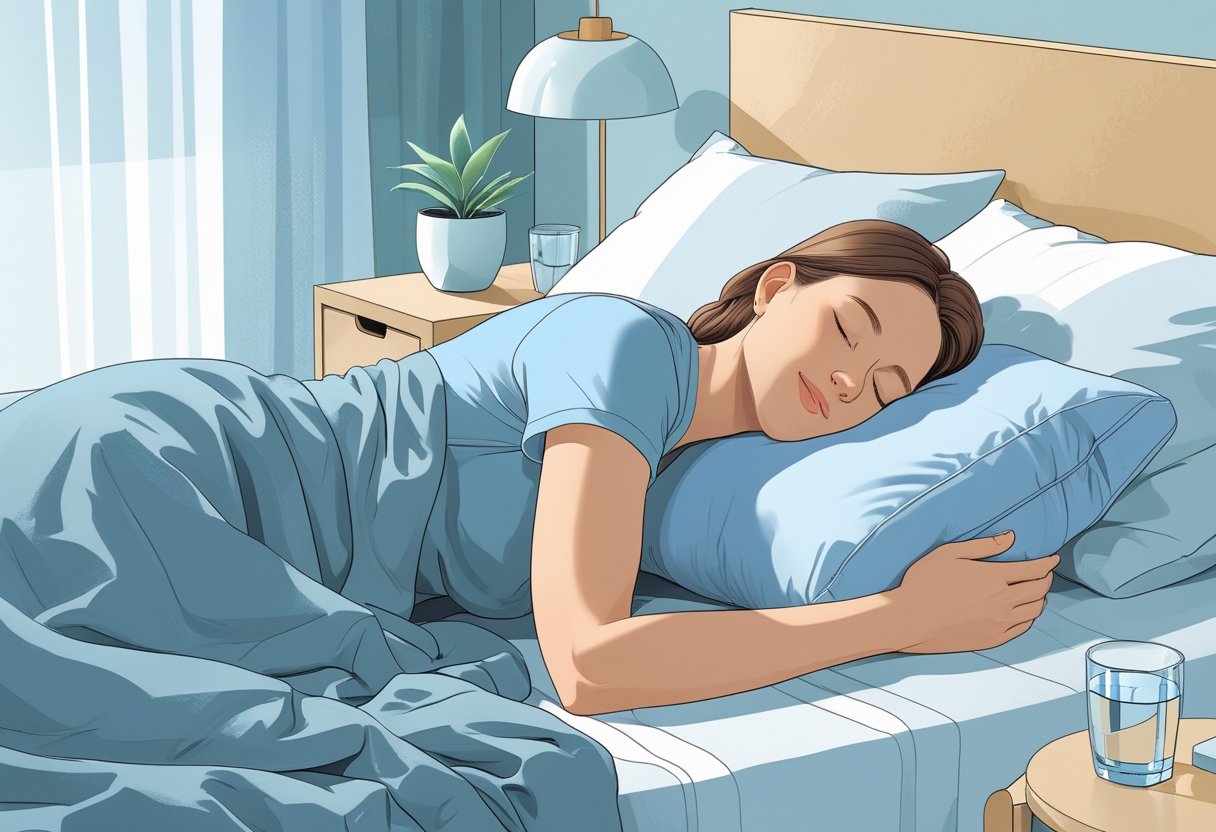
Managing upper back pain after sleep takes more than just switching positions. The right combination of treatments, therapies, and simple adjustments can ease pain between the shoulder blades and help reduce morning stiffness.
Pain Management Options
Pain relief ranges from basic over-the-counter meds to doctor-prescribed treatments. Nonsteroidal anti-inflammatory drugs (NSAIDs) like ibuprofen reduce inflammation and provide relief. For more severe or ongoing upper back and neck pain, doctors may recommend muscle relaxants or stronger medication. These should always be used under medical guidance to avoid unwanted side effects.
Physical therapy and posture-correcting exercises may also be suggested to strengthen muscles and prevent stiffness. In more serious cases, injections or even surgery might be considered.
Home Remedies and Therapies
Home treatments can go a long way in easing pain between the shoulder blades. Heat or cold packs applied to the sore area help lower inflammation and relax tense muscles. Morning stretches boost blood flow and improve flexibility, while massage therapy works to release muscle tension and reduce pain.
Better daytime posture eases strain on the upper back, and pillows that support proper neck alignment during sleep help stop pain from getting worse overnight.
Adjusting Sleep for Specific Medical Conditions
Some health issues need more specific sleep adjustments. People with obstructive sleep apnea or pregnant women should avoid lying flat on their back, as this can make symptoms worse or cause added discomfort.
Pregnant women sleep more comfortably on their side with a pillow between the knees to support the spine. People with sleep apnea benefit from side-sleeping with pillows that keep their airway open.
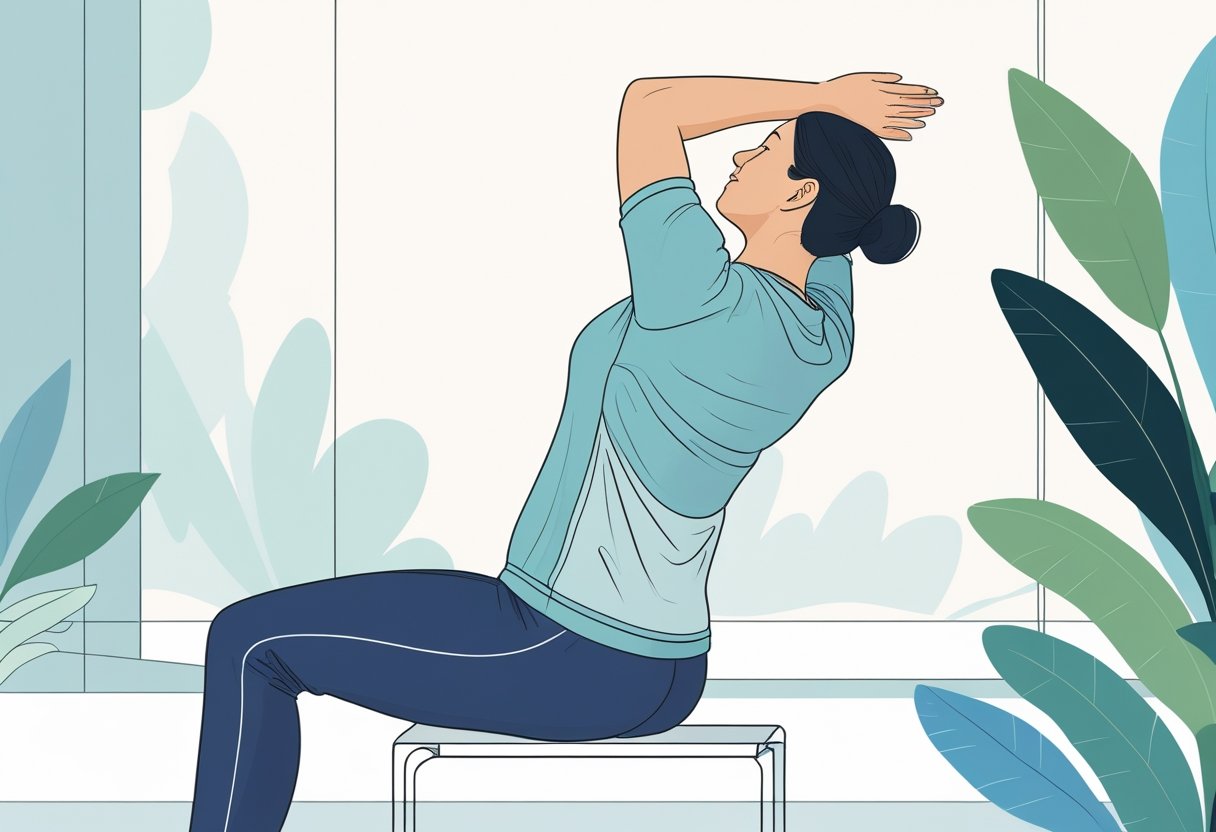
A mattress is important in relieving upper back pain by supporting the spine’s natural curve. The right mattress keeps the body aligned and reduces strain on muscles and joints throughout the night.
Mattress firmness is also essential. A medium-firm mattress provides the ideal mix of support and comfort. It prevents the mattress from sinking too deeply or feeling too rigid. Firmness should match the sleeper’s body weight and preferred sleeping position.
Different mattress materials have distinct benefits:
- Memory foam contours to the body, relieves pressure points, and distributes weight evenly.
- Latex provides firmer and more responsive support to help maintain spinal alignment.
- Hybrid mattresses combine coils and foam to deliver both structure and cushioning.
An old or worn-out mattress may cause or worsen upper back pain. Sagging areas can misalign the spine, which leads to stiffness and discomfort. Most experts recommend replacing a mattress every 7 years or once visible wear appears. A mattress topper can enhance comfort by adding an extra layer of cushioning. It also helps relieve pressure in sensitive areas such as the shoulders and upper back.
Sleep position influences how mattress quality affects pain. Side sleepers benefit from softer surfaces that cushion the shoulders while supporting the hips. Back sleepers require a firmer surface to maintain proper lumbar support.
For those seeking a firmer, eco-conscious option that blends latex with coils, the Brooklyn Bedding EcoSleep mattress provides a balanced feel and zoned support designed to promote better spinal alignment. This mattress features natural latex combined with pocketed coils for a breathable and durable surface. Its zoned coil system targets key areas such as the lower back and hips, which reduces pressure and supports proper posture throughout the night.
In addition, the Brooklyn Bedding EcoSleep mattress emphasizes sustainability by using eco-friendly materials and manufacturing processes. This attribute appeals to those who want a comfortable mattress aligned with environmentally responsible values.

Frequently Asked Questions
Proper sleeping positions keep the spine aligned and reduce strain on the upper back. Adjustments in bedding and sleep posture can ease discomfort. Certain pillows and mattresses provide better support, while gentle stretches relieve muscle tension. Lifestyle habits also influence pain levels during the night.







